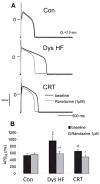Cellular and Molecular Aspects of Dyssynchrony and Resynchronization
- PMID: 26596804
- PMCID: PMC4660268
- DOI: 10.1016/j.ccep.2015.08.011
Cellular and Molecular Aspects of Dyssynchrony and Resynchronization
Abstract
Dyssynchronous contraction of the ventricle significantly worsens morbidity and mortality in patients with heart failure (HF). Approximately one-third of patients with HF have cardiac dyssynchrony and are candidates for cardiac resynchronization therapy (CRT). The initial understanding of dyssynchrony and CRT was in terms of global mechanics and hemodynamics, but lack of clinical benefit in a sizable subgroup of recipients who appear otherwise appropriate has challenged this paradigm. This article reviews current understanding of these cellular and subcellular mechanisms, arguing that these aspects are key to improving CRT use, as well as translating its benefits to a wider HF population.
Keywords: Animal models; Cardiac resynchronization therapy; Dyssynchrony; Myocyte; Myofilament.
Copyright © 2015 Elsevier Inc. All rights reserved.
Figures






References
-
- Ghio S, et al. Interventricular and intraventricular dyssynchrony are common in heart failure patients, regardless of QRS duration. Eur Heart J. 2004;25:571–8. - PubMed
-
- Schuster I, et al. Diastolic asynchrony is more frequent than systolic asynchrony in dilated cardiomyopathy and is less improved by cardiac resynchronization therapy. J Am Coll Cardiol. 2005;46:2250–7. - PubMed
-
- Vernooy K, et al. Left bundle branch block induces ventricular remodelling and functional septal hypoperfusion. Eur Heart J. 2005;26:91–8. - PubMed
-
- Burkhoff D, Oikawa RY, Sagawa K. Influence of pacing site on canine left ventricular contraction. Am J Physiol. 1986;251:H428–H35. - PubMed
Publication types
MeSH terms
Grants and funding
LinkOut - more resources
Full Text Sources
Other Literature Sources
Medical
Research Materials
Miscellaneous

